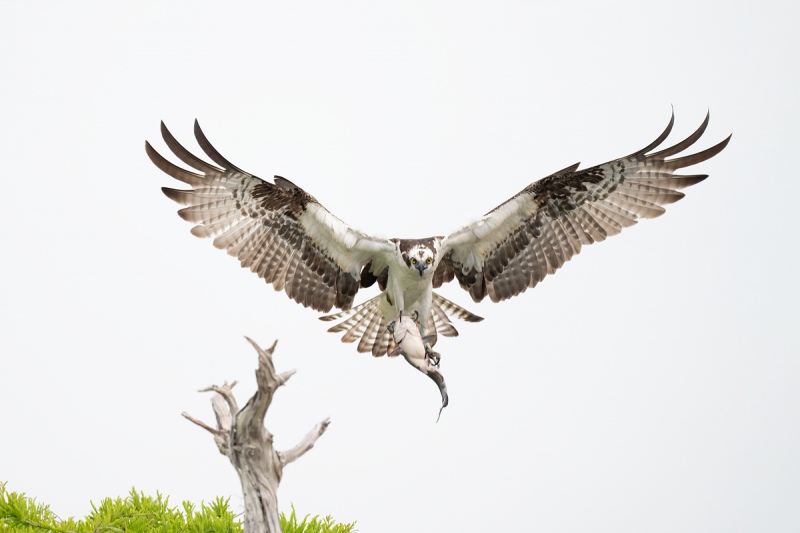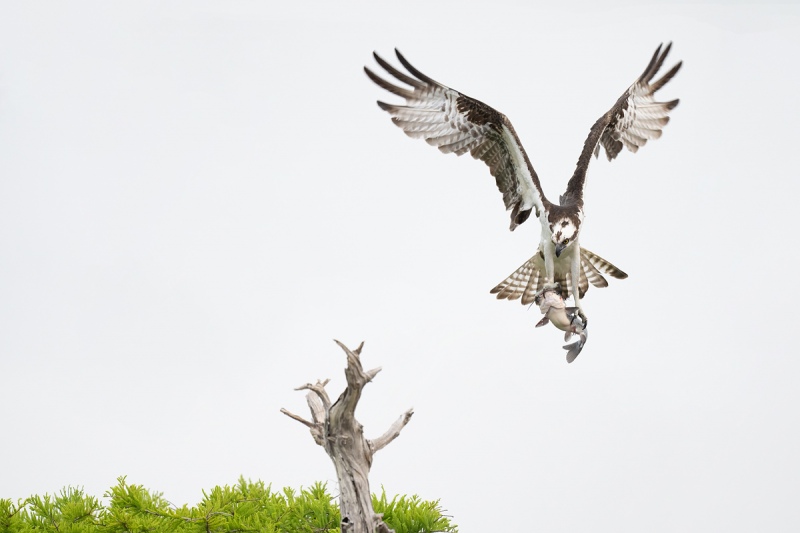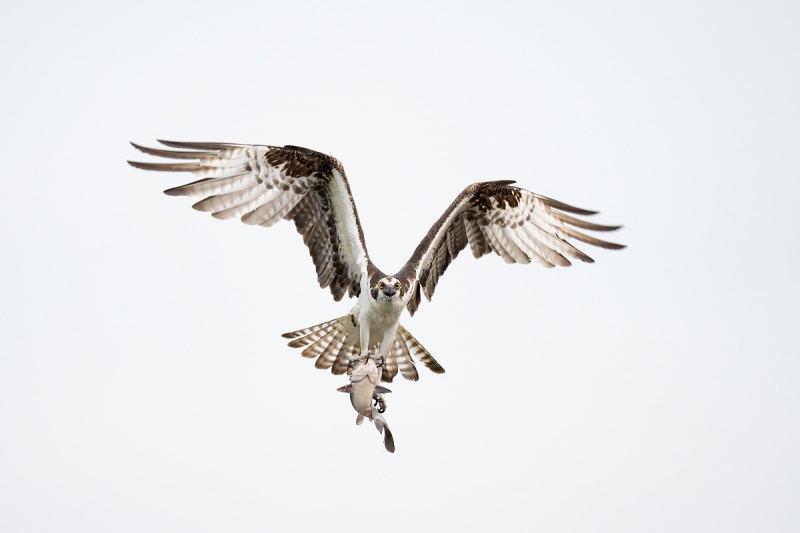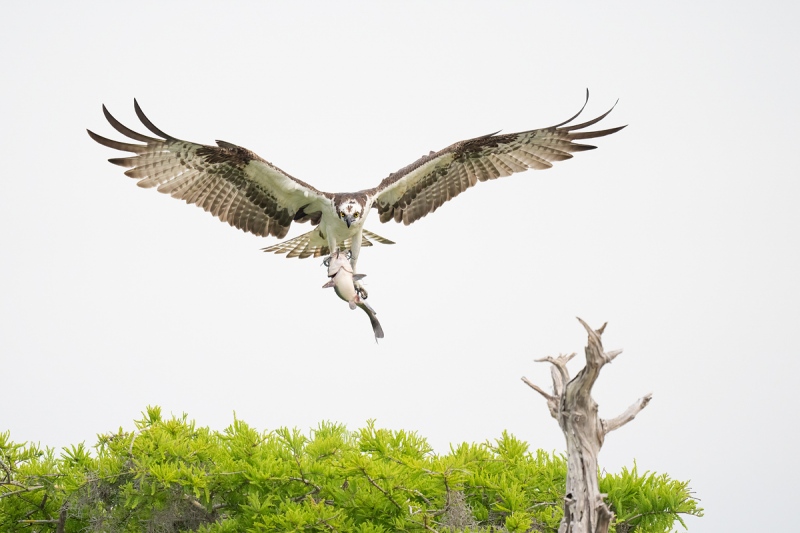Which is the Best Image?
Selecting my four favorites from the 48 keepers (out of 436 sharp images) after the first edit was a challenge. Now you face a tougher one: which of today’s four featured images is the strongest? All are invited to leave a comment and share their thoughts as to why.
What’s Up?
On Sunday morning, Clemens Van der Werf, Donna Bourdon, Anita North, and I photographed from Clemens’ flat boat. We tried for Snail Kites at a local lake near ILE. With the wind from the west southwest and the sun out most of the time we pretty much struck out with flight shooting but had a few decent perched males.
We headed back to my house for a smoked salmon brunch. Afterwards, I napped, swam, and finished packing. Clemens headed home and the three of us drove over to Gulfport for the second DeSoto IPT.
On Sunday evening, I met most of the group — Jim Miller is driving down from Tallahassee on Monday. We ran through the Designing and creating pleasing and dramatic natural history images and recorded the session with Camtasia. It will be available in the BAA Online Store soon.
Today is Monday 26 April 2021. The morning forecast for St. Pete is for clear with east northeast winds — not great, but pretty darned good. Wherever you are, and whatever you are doing, I hope that you have a great day.
This blog post took about two hours to prepare and makes 124 consecutive days with a new one. Please remember that if an item — a Delkin flash card, or a tripod head, for example, is available from B&H and/or Bedfords and is also available in the BAA Online Store, it would be great if you opt to purchase from us. We will match any price. Please remember also to use my B&H affiliate links or to save money at Bedfords by using the BIRDSASART discount code at checkout. Doing either often earns you free guides and/or discounts. And doing so always earns my great appreciation.
My Laptop
Many folks are not aware that I do all of my image processing on a MacBook Pro. Though less than ideal, it is — considering all of the traveling that I do, the best solution for me. And I love the speed and the 4TB internal hard drive. The Apple 16″ MacBook Pro (Updated in 2020, Space Gray) is the updated version of my 2019 device.
Please Remember
With income from IPTs now at zero, please, if you enjoy and learn from the blog, remember to use one of my two affiliate programs when purchasing new gear. Doing so just might make it possible for me to avoid having to try to get a job as a Walmart greeter and will not cost you a single penny more. And if you use Bedfords and remember to enter the BIRDSASART code at checkout, you will save 3% on every order and enjoy free second-day air shipping. In these crazy times — I am out at least forty to sixty thousand dollars so far due to COVID 19 (with lots more to come) — remembering to use my B&H link or to shop at Bedfords will help me out a ton and be greatly appreciated. Overseas folks who cannot order from the US because of import fees, duties, and taxes, are invited to help out by clicking here to leave a blog thank you gift if they see fit.
New and Better Bedfords Discount Policy!
You can now save 3% on all of your Bedfords photo gear purchases by entering the BIRDSASART coupon code at checkout. Your discount will be applied to your pre-tax total. In addition, by using the code you will get 2nd day air shipping via Fed Ex.
Grab a Nikon AF-S Teleconverter TC-14E III and save $14.99. Purchase a Canon EOS R5 and your discount will be $116.97. Purchase a Sony FE 600mm f/4 GM OSS lens and save a remarkable $389.94! Your Bedford’s purchase no longer needs to be greater than $1,000.00 for you to receive a discount. The more you spend, the more you save.
Money Saving Reminder
Many have learned that if you need a hot photo item that is out of stock at B&H and would enjoy free second-day air shipping, your best bet is to click here, place an order with Bedfords, and enter the coupon code BIRDSASART at checkout. If an item is out of stock, contact Steve Elkins via e-mail or on his cell phone at (479) 381-2592 (Central time). Be sure to mention the BIRDSASART coupon code and use it for your online order to save 3% and enjoy free 2nd-day air shipping. Steve has been great at getting folks the hot items that are out of stock at B&H and everywhere else. The wait lists at the big stores can be a year or longer for the hard to get items. Steve will surely get you your gear long before that. For the past year, he has been helping BAA Blog folks get their hands on items like the SONY a9 ii, the SONY 200-600 G OSS lens, the Canon EOS R5, the Canon RF 100-500mm lens, and the Nikon 500mm PF. Steve is personable, helpful, and eager to please.


Gear Questions and Advice
Too many folks attending BAA IPTs (remember those?) and dozens of photographers whom I see in the field and on BPN, are–out of ignorance–using the wrong gear especially when it comes to tripods and more especially, tripod heads… Please know that I am always glad to answer your gear questions via e-mail. Those questions might deal with systems, camera bodies, accessories, and/or lens choices and decisions.
|
|
|
This image was created on 24 April 2021 on Lake Blue Cypress working from Clemens Van der Werf’s flats boat. I used the hand held Sony FE 600mm f/4 GM OSS lens and The One, the Sony Alpha 1 Mirrorless digital camera. ISO 3200. Exposure determined via Zebras with ISO on the rear dial: 1/1250 sec. at f/4 (wide open) in Manual mode. AWB at 7:20:39am on a heavily overcast morning. Wide/AF-C was active at the moment of exposure and performed perfectly. Click on the image to see a larger version. Image #1: Osprey with whole catfish |
The Whole Catfish
It is common to see Osprey flying around with fish, but nine times out of ten they will have already torn off and eaten the fish’s head. Having this bird flying around and around with a whole, fresh caught catfish was a real treat.
Many Great Catfish Chances
We spotted this male Osprey with a large, whole catfish flying around while the light levels were still quite low; I was doing blurs. The first of two keeper blurs was created at 7:17:17am. Then I switched to sharp. The last keeper of what was a very long series was created at 7:25:06. I wound up with 48 keepers out of 436 sharp images.
The bird would fly into the nest, touch down briefly, take flight, and then circle around again. And again. And again. The show went on for about eight whole minutes. The male finally landed with its mate right on it tail. Breakfast time.
|
|
|
This image was also created on 24 April 2021 on Lake Blue Cypress working from Clemens Van der Werf’s flats boat. I used the hand held Sony FE 600mm f/4 GM OSS lens and The One, the Sony Alpha 1 Mirrorless digital camera. ISO 3200. Exposure determined via Zebras with ISO on the rear dial: 1/1250 sec. at f/4 (wide open) in Manual mode. AWB at 7:20:40am on a heavily overcast morning. Wide/AF-C was active at the moment of exposure and performed perfectly. Click on the image to see a larger version. Image #2: Osprey with whole catfish |
Gear and Shutter Speed Decisions
The 200-600 with the a1 is a deadly combination, especially when hand holding for flight photography. The 600 GM is much heaver, much larger, and thus — much more difficult to hand hold. So why not go with the 2-6?
In the extreme low light conditions of a very overcast morning, the 600 at f/4 saves you four clicks (1 1/3 stops) of ISO. Had In sunny conditions, I will almost always opt for the 200-600 for flight while choosing 1/3200 second as my ideal shutter speed. On Saturday morning, once I switched from doing blurs to trying to create sharp images, I really skimped on shutter speed by first working at 1/1250 second. When things brightened up a bit, I moved up to 1/1600 second. All of the images were more than sharp enough on the bird’s eyes.
|
|
|
This image was also created on 24 April 2021 on Lake Blue Cypress working from Clemens Van der Werf’s flats boat. I used the hand held Sony FE 600mm f/4 GM OSS lens and The One, the Sony Alpha 1 Mirrorless digital camera. ISO 3200. Exposure determined via Zebras with ISO on the rear dial: 1/1600 sec. at f/4 (wide open) in Manual mode. AWB at 7:23:25am on an overcast morning. Wide/AF-C was active at the moment of exposure and performed perfectly. Click on the image to see a larger version. Image #3: Osprey with whole catfish |
My Biggest Problem
Even though the SONY 600 f/4GM is the lightest (by one ounce over the Canon 600 III) 600 f/4 ever produced, my biggest problem was with the framing, keeping the bird in the center of the frame. Only practice and weight training can help me there.
The SONY AF System
The performance of the SONY AF system at any focal length (when the a1 is set up properly as detailed in the in e-mails to the Sony Alpha a1 Info & Updates group), continues to amaze me. Early on, there was lots of discussion within the group with many preferring multiple back button approaches. For me a simple shutter button approach with the right AF settings that yield 99% sharp-on-the-eye images is best. By far. It is super-simple and mega-effective.
SONY Alpha a1 Set-up and Info Group
The SONY Alpha a1 Set-up and Info Group is going great guns as folks chime in with thoughtful questions and experience-based advice. We are now up to an astounding 35 folks. Early on, we discussed the myriad AF options. I gave my opinion as to the best one for flight and general bird photography. More recently, we have been in contact with folks at SONY sharing our thoughts, experiences, and frustrations with the EVF blackout problem.
All who purchased their Alpha a1 bodies via a BAA affiliate link will receive a free subscription to the Sony Alpha a1 Set-Up and Info Updates after shooting me their receipts via e-mail. (Note: it may take me several days to confirm B&H orders.) This same service may be purchased by anyone with an a1 body via a $150.00 PayPal sent to birdsasart@verizon.net indicating payment for Alpha a1 Info Updates. Alternatively, they can call Jim weekday afternoons at 1-863-692-0906 to pay via credit card. New members will receive composite e-mails that summarize all previous discussions.
|
|
|
This image was also created on 24 April 2021 on Lake Blue Cypress working from Clemens Van der Werf’s flats boat. I used the hand held Sony FE 600mm f/4 GM OSS lens and The One, the Sony Alpha 1 Mirrorless digital camera. ISO 3200. Exposure determined via Zebras with ISO on the rear dial: 1/6000 sec. at f/4 (wide open) in Manual mode. AWB at 7:25:04am on an overcast morning. Wide/AF-C was active at the moment of exposure and performed perfectly. Click on the image to see a larger version. Image #4: Osprey with whole catfish |
Eye Doctor Work
In the dingy light, and with the bird’s nictitating membrane covering part of the eye or eyes in two of the four images, I did some eye doctor work on each of today’s featured images. I used the Clone Stamp Tool to lose the nictitating membrane, selected and brightened the yellow irises, and used Tim Grey Dodge and Burn to darken the pupils. Then I selected the bird’s face in each image and applied a Contrast Mask to selectively sharpen and darken that layer only.
|
|
The BIRDS AS ART Current Workflow e-Guide (Digital Basics II).You can order your copy from the BAA Online Store here, by sending a PayPal for $40 here, or by calling Jim or Jennifer weekdays at 863-692-0906 with your credit card in hand. Be sure to specify Digital Basics II. |
The BIRDS AS ART Current Workflow e-Guide (Digital Basics II)
The Eye Doctor and Contrast Mask techniques mentioned above, and tons more great Photoshop tips and techniques (with the exception of Capture One RAW Conversions) — along with all of my personalized Keyboard Shortcuts — are covered in detail in the BIRDS AS ART Current Workflow e-Guide (Digital Basics II), an instructional PDF that is sent via e-mail. Learn more and check out the free excerpt in the blog post here. While the new e-Guide reflects my MacBook Pro/Photo Mechanic/DPP 4/Photoshop workflow, folks using a PC and/or BreezeBrowser will also benefit greatly by studying the material on DB II. Note: folks working on a PC and/or those who do not want to miss anything Photoshop may wish to purchase the original Digital Basics along with DB II while saving $15 by clicking here to buy the DB Bundle.
Folks who learn well by following along rather than by reading can check out the complete collection of MP 4 Photoshop Tutorial Videos by clicking here. Note: all of the videos are now priced at an amazingly low $5.00 each.
You can learn how and why I converted all of my Canon digital RAW files in DPP 4 in the DPP 4 RAW Conversion Guide here. More recently, I became proficient at converting my Nikon RAW (NEF) files in Adobe Camera Raw. About two years ago I began converting my Nikon and Sony RAW files in Capture One Pro 12 and continue to do so today.
To purchase Capture One, please use this link. Then you can learn more about Capture One in the Capture One Pro 12 Simplified MP4 Video here. The next step would be to get a copy of Arash Hazeghi’s “The Nikon Photographers’ Guide to Phase One Capture One Pro e-Guide” in the blog post here.
You can learn advanced Quick Masking and advanced Layer Masking techniques in APTATS I & II. You can save $15 by purchasing the pair. Folks can learn sophisticated sharpening and (NeatImage) Noise Reduction techniques in The Professional Post Processing Guide by Arash Hazeghi and edited by yours truly. Please use this link to purchase NeatImage.
Typos
With all blog posts, feel free to e-mail or to leave a comment regarding any typos or errors.




















Hi Artie, I like 3 best, it is the most balanced, Ruthie
1,4,3,2. #1 is your huckleberry. Wing Position bird posture superb.
I like #1 the best. The direct look on the Osprey’s face makes the big difference for me. Background is okay there. I might have given it a little blur.
They are all truly great!
Quick question. Would you go with the 1.4 RF extender for the 100-500 over an RF 800 F11?
Thanks!
Mike
Thanks, Micheal. Id go with the 100-500 in a heartbeat because of faster lens speed and far more versatility.
with love, artie
No. 1 for me. I like the out stretched wings, fanned tail and enough of the habitat. The bird is larger in the frame which gives it a good balance. Then the order for me is 4, 2 and 3.
#2 for me. I like the wings stretched way up–seems more unusual to get that. And I like the bird looking at the tree perch. Tree and bird balance each other, especially since both are vertical shapes. Really like the white sky with no clouds to clutter things up. After #2, in order are 4 and 1. Not 3, I need some habitat.
#1 is my favourite
The Osprey is putting on the brakes and so shows the beauty of the wings in full, and the power of the Osprey. I also like the positioning of the bird, the perch, and the tree tops in the image.
My preference is #4, #1, #3, then #2 in that order. Here is why:
You have been teaching us to include some green in the photo. In that regard, #3 would’ve immediately taken the last place. But the Osprey in #2 is looking away and the left wing of the bird appears as if it is missing the secondary feathers. That’s why #2 gets last place.
It was a challenge to choose between #1 and #4. While I like the wings of #1 better, overall it doesn’t seem as balanced compositionally and the Osprey is too close to the middle. #4 nicely balances with the Osprey towards the upper left with the tree in the lower right. Also the green foliage positions the Osprey above it nicely.
You will have to us which one is your favorite and why 🙂
Well thought out, Muhammad.
with love, a
# 3 hands down, clean view everything in proper spacing- a real winner.
Don
I spoke to the catfish and he didn’t care for any of them 😉
1. We don’t see the Osprey as well as the other 3 images.
2. Not as good a view of the Osprey’s eyes.
3. Part of the story is lost when we no longer see the trees.
4. I feel like the Osprey is staring at me defiantly – This one is my preference.
Now, if you could capture both the fish and the Osprey looking at us, that would be extra frosting on an already very tasty cake.
#3 Hands down! Best picture of the osprey — you can really see it’s eyes. What an enormous catfish.
Hi Artie, great minds think alike and this weekend I was in the great white north watching the Ospreys as well. The female was on the nest, while the male was huddled down against the freezing cold (40 deg F) and brisk winds. Sun angle wasn’t an issue as there wasn’t any and the wind angle was completely wrong (in my face). After freezing for a couple of hours, the clouds broke slightly and the male jumped from his perch to do some fishing.
I think your points regarding the use of large primes in marginal light cannot be under-emphasized. Though with the current generation MILC’s the AF capabilities are astounding, without a large prime, I would have been shooting at unusable ISO’s to achieve a decent Tv. As it were, I struggled with the large prime (tripod mounted) keeping the bird in frame during the dive sequences.
Of the images you posted, I give the nod to 3 & 1 for the eye engagement. While some environment context can be helpful, I find the sliver of green foliage distracting in 1, better in 4 though the later image loses out on lack of eye contact. Admittedly, I struggle with images like 3 when the sky is nothing more than a uniform gray nothingness and it certainly would have been more interesting with sky/clouds, water, etc. though it is what it is. FWIW, my best images yesterday were of the Osprey wet, shaking off the water, while clutching the fish in its talons against a blue/white bokeh of the water.
Out of curiosity, have you determined whether to leave IS on or off when shooting at high Tv’s with the A1? I think I may have left it on with my R5 yesterday and that contributed to some issues when shooting at Tv 1/3200.
I prefer #4, then #2. (Most people so far have not liked #2). I know you typically want eye connection with the bird to draw in the viewer, but in these environmental portrait shots, when the osprey is looking right at you just seems to be “invasive” or not natural than a connection.
In Image #2, he is clearly looking at his landing spot to have breakfast – good story telling. I like #4 the best due to the vegetation, the head turn toward the nest and still a since of connection in the eyes.
#1, the perch and vegetation add context and the osprey’s pose makes it a standout form me. Next would be 4, 3 then 2. All are special.
I prefer #3. I like the isolation and don’t believe that the tree adds to environmental understanding of the image. If it was flying low over water that would probably change my mind
Hi Artie,
My preference would be the last image, #4. The balance of the image with the vegetation across the bottoms, the dead tree on the right and the bird slightly left makes for a good “environmental” image, telling a story. If it were mine, I would consider providing a bit more contrast to an otherwise somewhat flat image. Good job hand holding the 600. If I were smart, I would be working with my weights to attempt to make it a bit easier. If I were only 20-30 years younger!
#3 & 4 for me. I like the isolation and bird’s head/face position of #3, and like the environment of #4.
I think 1/6000 sec is a typo in #3 & 4. I think you meant 1/1600sec.
Thanks and fixed on the typo.
with love, artie
Would vote for #1. Wing position, proximity to tree, and believe tree adds to interest. Very nice.
#4 and #1 for me.
On #4 I would have cropped the blank right part that goes down to the bottom of the frame in order to keep only some green in the bottom of the frame.
then #3 and #2.
This is my ranking of these four images.